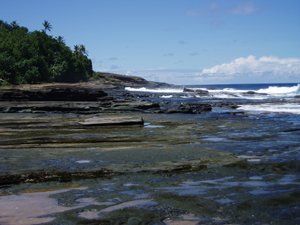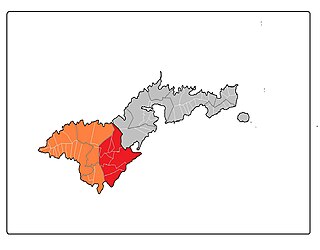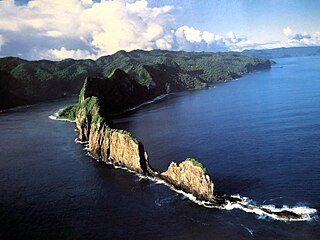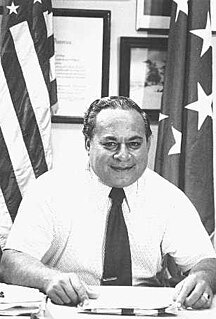
Pago Pago is the territorial capital of American Samoa. It is in Maoputasi County on the main island of American Samoa, Tutuila. It is home to one of the best and deepest natural deepwater harbors in the South Pacific Ocean, sheltered from wind and rough seas, and strategically located. The harbor is also one of the best protected in the South Pacific, which gives American Samoa a natural advantage with respect to landing fish for processing. Tourism, entertainment, food, and tuna canning are its main industries. Pago Pago was the world's fourth largest tuna processor as of 1993. It was home to two of the largest tuna companies in the world: Chicken of the Sea and StarKist, which exported an estimated $445 million in canned tuna to the U.S. mainland.

Tutuila is the largest and the main island of American Samoa in the archipelago of Samoan Islands. It is the third largest island in the Samoan Islands chain of the Central Pacific located roughly 4,000 kilometers (2,500 mi) north-east of Brisbane, Australia and over 1,200 kilometers (750 mi) northeast of Fiji. It contains a large, natural harbor, Pago Pago Harbor, where Pago Pago, the capital of American Samoa is situated. Pago Pago International Airport is also located on Tutuila island. Its land expanse is about 68% of the total land area of American Samoa and with 56,000 people accounts for 95% of its population. The island has six terrestrial and three marine ecosystems.

Fagatogo is the Downtown area of Pago Pago, the territorial capital of American Samoa. It is the seat of the judiciary, and it is the commercial center of Tutuila Island. Its population is 3,000. Fagatogo is the location of the American Samoa Fono (legislature), and is listed in the Constitution of American Samoa as the territory's official seat of government. Fagatogo is the seat of government and the financial, commercial, and shipping center of American Samoa.

Utulei is a village in Maoputasi County in the Eastern District of Tutuila, the main island of American Samoa. Utulei is the legislative capital of American Samoa, and is located east of Pago Pago. It is home to most hotels and most historic buildings in Pago Pago. The Executive Office Building is located here, just next to Feleti Barstow Library and paved roads that wind up to the former cablecar terminal on Solo Hill. Lee Auditorium, which was built in 1962, is also located in Utulei. American Samoa’s television studios, known as Michael J. Kirwan Educational Television Center, and the Rainmaker Hotel, are also found in Utulei. Utulei Terminal offers great views of Rainmaker Mountain.

Rainmaker Mountain is the name of a mountain located near Pago Pago, American Samoa on Tutuila Island. Rainmaker Mountain traps rain clouds and gives Pago Pago the highest annual rainfall of any harbor in the world. The average annual rainfall on the mountain is around 200 inches. It has a three-pronged summit. Rainmaker Mountain and its base were designated a National Natural Landmark in 1972 due to the slopes’ tropical vegetation.

Leone is a village on the south-west coast of Tutuila Island, American Samoa. Leone was the ancient capital of Tutuila Island. Leone was also where the Samoan Islands’ first missionary, John Williams, visited on October 18, 1832. A monument in honor of Williams has been erected in front of Zion Church. Its large church was the first to be built in American Samoa. It has three towers, a carved ceiling and stained glass. Until steamships were invented, Leone was the preferred anchorage of sailing ships which did not risk entering Pago Pago Harbor. Much early contact between Samoans and Europeans took place in Leone.

American Samoa is an unincorporated territory of the United States located in the South Pacific Ocean, southeast of Samoa. Its location is centered on 14.2710° S, 170.1322° W. It is on the eastern border of the International Date Line, while independent Samoa is west of it.

Ālega is a village on the southeast coast of Tutuila Island, American Samoa. One of the island's least populous villages, it is located to the east of Pago Pago Harbor and to the west of Faga'itua Bay.

'Aoa is a village on the north-east coast of Tutuila Island, American Samoa. It is located on the north coast, close to the island's eastern tip, at a narrowing of the island and is connected by road with Amouli on the south coast. Aoa is the oldest site on Tutuila to yield ceramics. Located in a large U-shaped valley on the northeast coast of the island, Aoa sits on a wide, sandy beach fronted by a large, deep bay. Fresh water is supplied by a steady river which runs through the village. It is located in Vaifanua County.

Faga'alu is a village in central Tutuila Island, American Samoa. It is located on the eastern shore of Pago Pago Harbor, to the south of Pago Pago. American Samoa's lone hospital, Lyndon B. Johnson Tropical Medical Center, is located in Faga'alu. The village is centered around Fagaalu Stream.

The Jean P. Haydon Museum is a museum in Pago Pago dedicated to the culture and history of the United States territory of American Samoa. It contains a collection of canoes, coconut-shell combs, pigs’ tusk armlets and native pharmacopoeia. It also houses exhibits on natural history, tapa making, traditional tattooing, as well as a collection of war clubs, kava bowls, and historic photographs. Constructed in 1913 as U.S. Naval Station Tutuila Commissary, the building was home to Tutuila Island's Post Office from 1950-1971. The museum has displays of various aspects of the Samoan Islands’ culture and history. It is the official repository for collections of artifacts for American Samoa. Funded by the American Samoa Council on Arts, Culture and the Humanities, it is the venue used for numerous of the cultural resource activities in American Samoa.

Vatia is a village on Tutuila Island in American Samoa. It is a north shore village located on Vatia Bay. The road to Vatia, American Samoa Highway 006, is the only road going through National Park of American Samoa. Vatia is a scenic community at the foot of Pola Ridge and surrounded by the national park. It is only reached by Route 6 which traverses the national park before reaching Vatia. There was once a hiking trail over Maugaloa Ridge from Leloaloa, but since the completion of Route 6, this trail is now overgrown. It is home to a beach, and panoramic views of jungle-covered peaks surround the village on all sides. Vatia is the center of the Tutuila-section of National Park of American Samoa. It is located in Vaifanua County.

Tula is a village in the Eastern District of Tutuila Island in American Samoa. Tula is located in Vaifanua County and had a population of 413 as of the 2000 U.S. Census.
Fagatogo Market is a market in the downtown Fagatogo area of Pago Pago, the capital of American Samoa. The market opened in 2010 as a market for farmers and fishermen to sell fruits, vegetables and fish. Souvenirs are often sold here when cruise ships are in town, and there’s often live music and entertainment at the market. The main bus terminal in Pago Pago is located behind Fagatogo Market. It is the center of Pago Pago, and sits next-door to Fagatogo Square Shopping Mall. Mount 'Alava, the canneries in Atu'u, Rainmaker Mountain, and Pago Pago Harbor are all visible from the market.

Fagasā is a village in the Eastern District of Tutuila Island in American Samoa. The village lies by Fagasa Bay, on the north shore of the island. Its name is Samoan and translates to “Forbidden Bay.” The village borders the Tutuila-section of National Park of American Samoa. The trailhead to Mount ‘Alava is located near the village by Fagasa Pass.

Taputimu is a village in southwestern Tutuila Island in American Samoa. It is the nearest village to the Fagatele Bay National Marine Sanctuary, although the main access is from the neighboring village of Futiga. It is home to Leala Shoreline National Natural Landmark and Leala Sliding Rock. It is located in Tualatai County in the Western District of Tutuila.

Tuālāuta County is a county in the Western District in American Samoa. It is the largest and also the most populated county in American Samoa. The county is represented by two seats in the Senate and two seats in House of Representatives in the American Samoa Legislature.
Amalau is the name of a valley and a bay within the National Park of American Samoa. Amalau Valley is located between Vatia and Afono, and it is an isolated valley with various wildlife such as large numbers of native bird species and flying fox megabats. Amalau Valley is reached on the road leading to Vatia. There are only a few homes at Amalau.

Pola Island is an island off the shores of Vatia on Tutuila Island in American Samoa. It is also known as Cockscomb. Pola Island is one of the most popular attractions in National Park of American Samoa. It is located on the west side of Vatia Bay and has become a landmark and an icon for Vatia. Pola Island has been named one of American Sāmoa’s Seven National Wonders by the Pago Pages. It has been named "the most beautiful natural feature of Tutuila Island” by travel guide publisher Lonely Planet.












